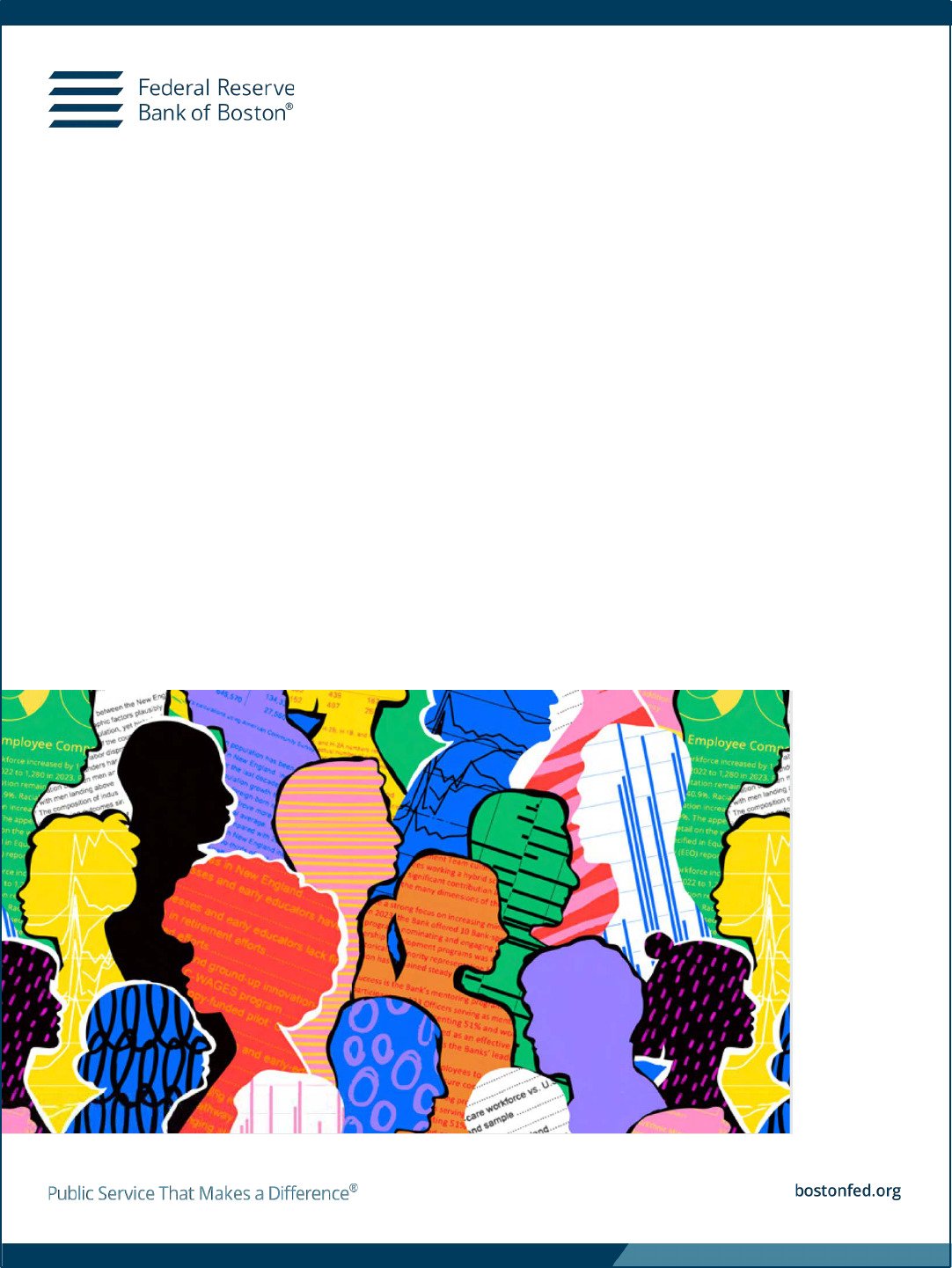
March 29, 2024
2023 Annual Report
to Congress
Office of Minority and Women Inclusion
2023 Annual Report to Congress
© 2024 Federal Reserve Bank of Boston. All rights reserved.
Contents
Message from the President and the OMWI Director ........................................................ 1
Section I. Introduction and Report Overview ..................................................................... 2
Section II. Our Bank ........................................................................................................... 3
A. Bank Overview ........................................................................................................... 3
B. The Bank’s Economic Research ................................................................................ 6
C. Community Development Activities ............................................................................ 8
Section III. The Bank’s Commitment to a Diverse and Inclusive Workforce .................... 11
A. Successes, Strategies, and Initiatives ...................................................................... 11
B. Ongoing Challenges and Next Steps ....................................................................... 20
C. Workforce: Demographic Composition Results ....................................................... 21
Section IV. The Bank’s Inclusion of Minority- and Women-Owned Vendor Businesses:
Supplier Diversity Program .............................................................................................. 23
A. Successes ................................................................................................................ 23
B. Challenges and Next Steps ...................................................................................... 24
Section V. Concluding Observations ............................................................................... 25
Appendix A: EEO1 Report ............................................................................................... 27
Appendix B: OMWI Standard Metrics Report .................................................................. 29
Appendix C: 2023 Learning and Development Training Programs .................................. 32
Appendix D: Organization Chart ...................................................................................... 33

2023 Annual Report to Congress
Federal Reserve Bank of Boston | bostonfed.org | Office of Minority and Women Inclusion
1
Message from the President and the OMWI Director
In accordance with Section 342 of the Dodd-Frank Wall Street Reform and Consumer
Protection Act of 2010, the Federal Reserve Bank of Boston (“the Bank” or “Boston Fed”)
is pleased to provide Congress with the 2023 Annual Report of the Bank’s Office of
Minority and Women Inclusion (OMWI).
OMWI works in partnership with the Bank’s leadership team to help ensure individuals
and businesses have fair access to career and procurement opportunities. It does this by
collaborating across the organization to promote inclusive management practices and
equal employment opportunities.
This year, the Bank launched initiatives to align diversity, equity, and inclusion (DEI)
strategies across the organization and continued the successful integration of DEI
principles into policies and practices. Notable accomplishments include the following:
100% of Bank departments now have a DEI action plan; three new employee resource
networks (ERNs) were created to support and enhance an inclusive culture; and
performance ratings were further calibrated across the organization to promote greater
consistency, supporting more equitable availability of opportunities.
In terms of our external initiatives, the Bank pursued its mandate from Congress and our
commitment to a vibrant economy that works for all people in the region through a variety
of activities. This report includes descriptions of relevant activities, including work
supporting community economic development and financial literacy, economic research,
and our supplier diversity program.
The enclosed report provides information on the Bank’s regional footprint and insight on
our DEI successes and challenges. It highlights key initiatives aimed at continuing
progress on OMWI-related objectives, and it shares qualitative and quantitative data that
demonstrate the Bank’s progress in our mission to foster a vibrant, inclusive economy
that works for all. We are encouraged by the results and committed to continuing to
advance diversity, equity, and inclusion in our organization—and to ensuring
procurement opportunities are available to vendors throughout the region.
Susan M. Collins Danny Best
President and Chief Vice President and
Executive Officer OMWI Director
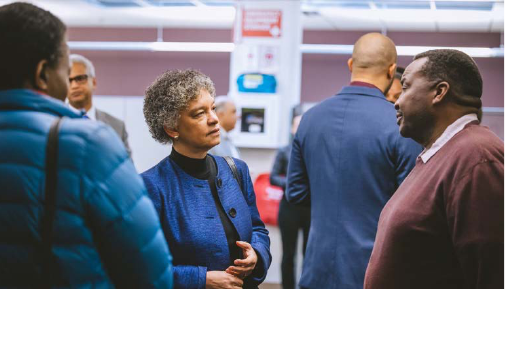
2023 Annual Report to Congress
Federal Reserve Bank of Boston | bostonfed.org | Office of Minority and Women Inclusion
2
Section I. Introduction and Report Overview
At the Federal Reserve Bank of Boston (“the Bank” or “Boston Fed”), we believe diversity
is a defining strength of our nation, the region, and the most effective organizations. We
believe that a diverse workforce and inclusive culture at the Boston Fed are essential to
fulfilling the Congressional mandates of stable prices and maximum employment, and to
achieving our overarching goal of fostering a vibrant economy that works for all people,
not just some people.
This orientation is reflected in the breadth of work undertaken across the Bank’s portfolio,
with some highlights mentioned in this report. As a case in point, President Collins
regularly spends time in every New England state, engaging with stakeholders across the
many facets of the economy to hear about their experiences and the economy’s
opportunities and challenges.
In 2023, the Bank conducted a holistic
review and update of its strategic plan.
The updated strategic plan aims to
guide the Bank’s operations and goals
through 2026. A theme throughout the
planning process was the need to
maintain the Bank’s commitment to
provide access to equal opportunity to
its workforce and the public, to
support our work to serve all
participants in the economy.
This report begins with an overview of
the Bank and our activities (Section
II). It highlights some of our economic research work and our community development
activities, including aspects of our outreach work that support greater financial literacy.
Section III outlines the Bank’s commitment to a diverse and inclusive workforce,
describing strategies, initiatives, and successes in 2023 and detailing our workforce
demographic composition. That section concludes with a summary of some ongoing
challenges and next steps. Section IV provides an update on our supplier diversity
programs. The report’s final section is a brief conclusion, followed by an appendix with a
number of supporting materials.
Boston Fed president Susan M. Collins speaks with
Vermont leaders during a 2023 visit to the state.
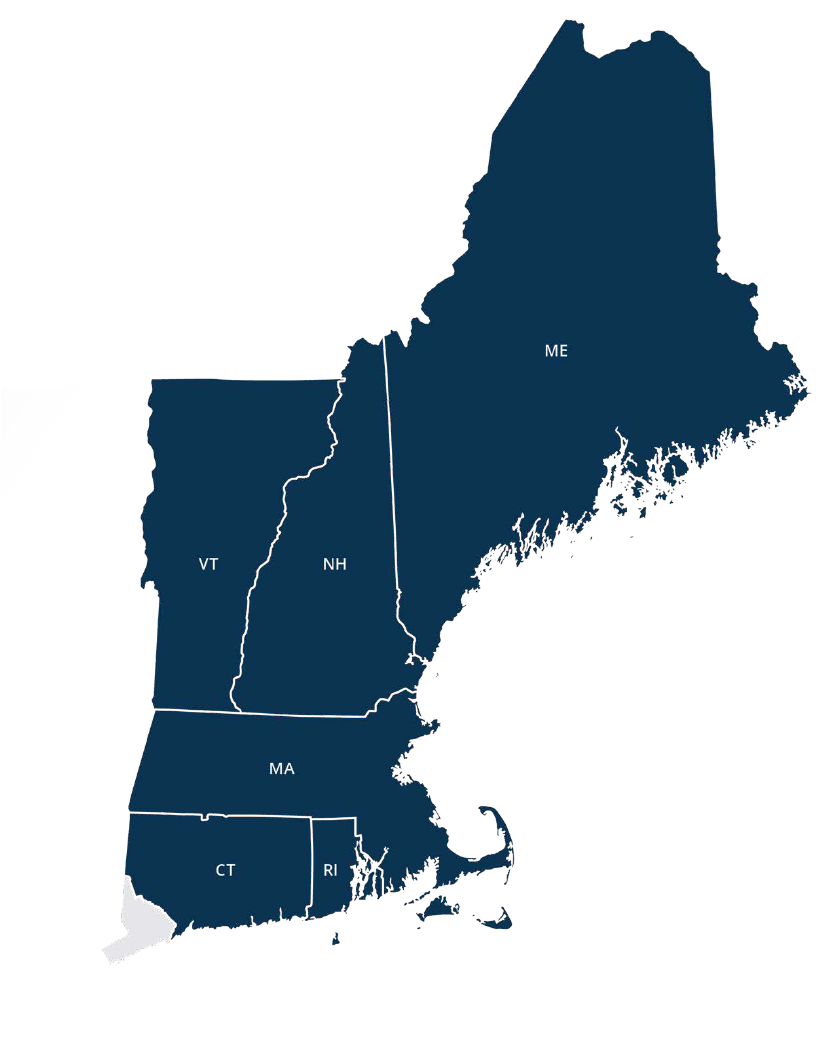
2023 Annual Report to Congress
Federal Reserve Bank of Boston | bostonfed.org | Office of Minority and Women Inclusion
3
Section II. Our Bank
A. Bank Overview
Who We Are
The Boston Fed is one of 12 regional Banks that, along with the Board of Governors in
Washington, make up the Federal Reserve System, established in 1914. Thus, the
Boston Fed plays a crucial role in the U.S. monetary and financial systems. The Bank
serves the First Federal Reserve District, which includes the six New England states:
Connecticut (except Fairfield County), Maine, Massachusetts, New Hampshire, Rhode
Island, and Vermont.

2023 Annual Report to Congress
Federal Reserve Bank of Boston | bostonfed.org | Office of Minority and Women Inclusion
4
Our Vision and Mission
The Bank is committed to promoting a strong, vibrant, and inclusive economy that works
for all. This aligns with the broader goals of the Federal Reserve System. The Bank
works diligently to serve the public by maintaining a safe and stable financial system,
promoting economic growth characterized by full employment and stable prices (the two
facets of our dual mandate from Congress), and ensuring the smooth functioning of
payment systems.
Boston Fed leadership believes that a truly healthy economy provides ample
opportunities to work, contribute, and prosper, regardless of an individual’s background
and identity. This requires the best ideas, energy, and participation from all. The Bank’s
staff pursues this mission through a variety of tasks and initiatives that address the
unique economic conditions and challenges faced by New Englanders.
Our Workforce
As of Dec. 31, 2023, the Bank had a workforce of 1,280 employees.
What We Do
The Boston Fed performs several core functions that are essential to achieving our vision
of promoting a vibrant, inclusive economy. These functions can be broadly categorized
as monetary policy contributions; nonpartisan economic research; community economic
development efforts; promoting financial stability; payments services and innovation; and
supervision, regulation, and credit. The following is a high-level summary of the Bank’s
functions:
Monetary Policy
The Boston Fed’s president is an active participant in the Federal Open Market
Committee (or FOMC), which sets the nation's monetary policy by influencing interest
rates and the money supply in pursuit of maximum employment and stable prices.
Economic Research
The Research department of the Boston Fed conducts rigorous, empirical, nonpartisan
research. In addition to work that contributes directly to monetary policymaking, such as
deepening understanding of inflation, employment, financial markets, and economic
growth, our experts study a range of topics related to fostering a vibrant economy. This

2023 Annual Report to Congress
Federal Reserve Bank of Boston | bostonfed.org | Office of Minority and Women Inclusion
5
includes work on issues that impact opportunities to participate in the workforce and
economy, as discussed further below.
Payments Services and Innovation
The Boston Fed provides essential services that underpin the banking and financial
system, assisting financial institutions of all sizes in serving their customers. The Bank
also conducts research supporting the continued evolution of the payments system,
including its underlying technologies and standards.
A key initiative has been the
development of the FedNow
®
Service,
created to provide real-time settlement
for instant payments and offer the
nation a faster and more efficient
payments infrastructure. The service
was launched in July 2023, and it
allows businesses and individuals to
send and receive instant payments at
any time of day through participating
financial institutions.
Other payments work includes secure
payments innovation and research,
designed to identify and address fraud challenges; work on central bank digital
currencies, focused on assessing evolving trends and developing knowledge that would
be necessary should Congress instruct the Federal Reserve to take action; and digital
and mobile payments research.
Supervision, Regulation, and Credit
The Boston Fed supervises financial institutions in the First District, at the behest of the
Board of Governors in Washington. This work serves the public by promoting financial
stability and public confidence in the banking system. The Bank works to protect
consumers by ensuring that financial institutions comply with laws and regulations, and
by encouraging those institutions to responsibly meet community needs.
Community Development
The Boston Fed team works to advance economic well-being and stability in low-and
moderate-income (or LMI) communities throughout New England. The work of promoting
economic growth and financial stability for LMI communities includes several key
initiatives: Supporting growth in smaller industrial cities and rural communities, research
and convening that advances household economic security and equity, and thought
leadership around expanding economic opportunities. Through outreach and
partnerships, the Boston Fed strives to enable progress in LMI communities. Some of this
work is described in more detail below.
The FedNow
®
Service for instant payments launched on
July 20, 2023.
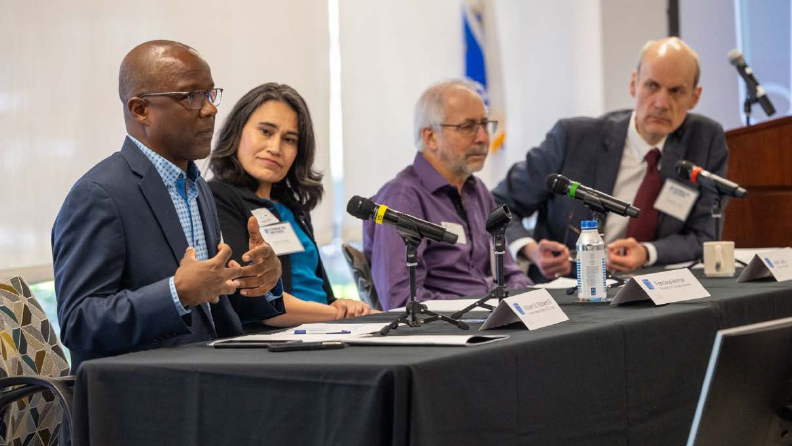
2023 Annual Report to Congress
Federal Reserve Bank of Boston | bostonfed.org | Office of Minority and Women Inclusion
6
B. The Bank’s Economic Research
Boston Fed economist Christopher L. Foote moderates the panel "Race-Related Gaps in
Employment Rates" during the Bank's 67th Economic Conference, which analyzed
barriers to "full employment."
The Bank conducts rigorous academic research to enrich our understanding of the
regional, national, and international economies and to contribute to the set of analytic tools
and perspectives that inform our monetary policy contributions. This includes research on
issues that impact opportunities to participate in the workforce and the economy.
Ongoing economic research activities include the following:
• Producing working papers and briefs that disseminate empirical and theoretical
research and cover topics such as macroeconomics, monetary policy, finance, and
public policy. This work may have a regional, national or international focus.
• Illuminating regional economic conditions, data, and trends via paper series and data
products produced by our New England Public Policy Center.
• Publishing policy reports featuring descriptive, research-based analysis that provide
comprehensive understanding of issues confronting citizens and policymakers.
• Supporting our Board of Directors by providing analysis for their Primary Credit Rate
recommendations to the Board of Governors. These rates play a role in monetary
policymaking by affecting borrowing costs for financial institutions.
• Conducting regular interviews with regional businesses to yield qualitative information
for the Fed’s periodic Beige Book report on economic and business conditions.
These and other insights complement quantitative data, enriching Fed policymakers’
understanding of economic conditions.

2023 Annual Report to Congress
Federal Reserve Bank of Boston | bostonfed.org | Office of Minority and Women Inclusion
7
• Engaging in debate on current economic and monetary policy concerns via
participation in conferences, seminars, media interviews, and speaking engagements.
Specific 2023 research initiatives that relate to barriers to inclusion in the economy
included the following:
• Examining patterns in unemployment rates by race and ethnicity and potential
implications for the labor market.
• Producing several working papers and briefs that address workforce development
and economic opportunity in the New England region, household finance, and
economic well-being. Examples include child care and women’s labor force
participation, “gig” work and its implications for employment measurement, and
challenges related to working students and credit access.
• Hosting the Bank’s 67th Economic Conference, “Rethinking Full Employment,” at
which participants analyzed barriers to full employment (one aspect of the Fed’s dual
mandate from Congress) and explored past and current thinking on measuring
maximum employment. The conference explored factors and policies that likely
prevent the full labor market participation of some groups.
1
• Gathering business leaders, community development practitioners, and financial
market participants for a session of the Federal Reserve System’s “FedListens”
initiative to discuss post-pandemic economic recovery.
2
• In 2023, the Boston Fed made regional economic data more accessible to public
audiences, supporting education and awareness about the region’s economy and the
Bank’s goal of fostering a more inclusive economy for all. One example is the “New
England Economic Conditions memo,” which informs monetary policymaking and
profiles payroll employment, unemployment and labor force participation, inflation,
and housing activity in the six New England states. The memo is now regularly
posted to the public website and shared proactively with subscribers on email and via
the Bank’s social media channels.
1
Including women, minorities, and formerly incarcerated populations.
2
As part of the Federal Reserve System’s Fed Listens series, the Bank held a regional
event focused on “Transitioning to the Post-pandemic Economy.” Event participants
aimed to better understand how the pandemic reshaped the New England economy and
its workforce. The discussion focused on labor market transitions, the housing market,
and state and local government fiscal health. The event attracted regional leaders from
business, nonprofits, and state and local government. Attendees gave Federal Reserve
staff, including Governor Michelle Bowman and President Susan M. Collins, insights and
first-hand accounts about the region’s post-pandemic challenges and opportunities.

2023 Annual Report to Congress
Federal Reserve Bank of Boston | bostonfed.org | Office of Minority and Women Inclusion
8
C. Community Development Activities
The city of Bath, Maine, member of the Sagadahoc team participating in the Bank’s
Working Communities Challenge.
Given its mission and mandate, the Bank works to support community economic
development, especially in places where economic outcomes have lagged. The Bank
looks to advance equitable opportunities for underserved households and communities in
New England. This work includes the following initiatives:
Supporting economic growth in smaller industrial
cities and rural communities
The Boston Fed actively engages in research, convening, and field support for about 30
of New England’s smaller cities and rural areas.
3
The focus is on supporting local efforts
to improve prospects for low-and moderate-income residents.
A key project includes the Working Places programs, externally funded competitions that
boost local collaborative leadership efforts to improve economic outcomes for lower-
income residents. In 2023, Working Places primarily focused on rural economic mobility
in Vermont and Maine, where residents from 14 communities are at work and using the
program as a catalyst. In many cases, the focus has been on growing the workforce,
including an emphasis on opportunities for youth, single mothers, and immigrant
populations. The overall goal is to build strong economies and communities in New
England’s smaller cities and rural towns.
3
In many of New England’s once-thriving smaller cities, the decline of manufacturing
significantly decreased opportunity. New England’s rural areas have also seen decline in
core industries as its workforce ages and contracts.
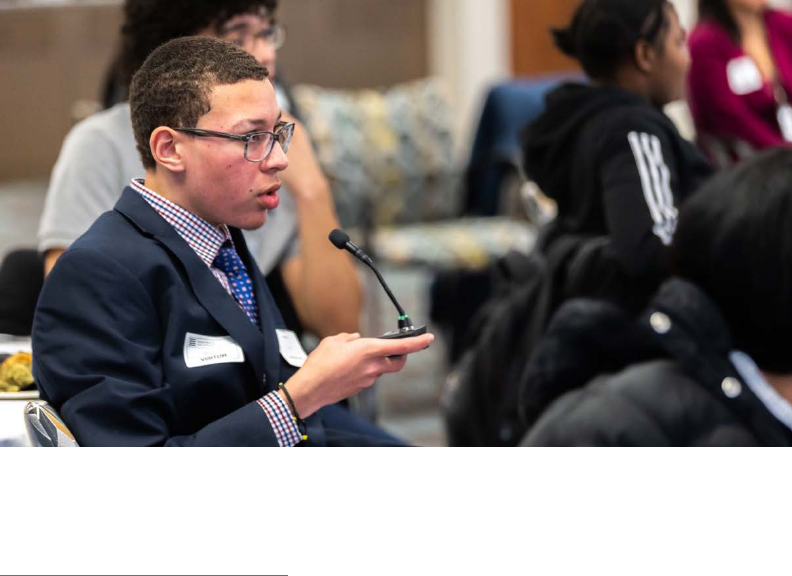
2023 Annual Report to Congress
Federal Reserve Bank of Boston | bostonfed.org | Office of Minority and Women Inclusion
9
Additionally, in 2022, the Bank launched an 18-month pilot program called Leaders for
Equitable Local Economies (or LELE) to encourage and equip local leaders working to
support stronger economies for smaller cities and rural areas.
4
Reducing Wealth Disparities
The Bank has long studied disparities in economic outcomes. This is motivated by our
mandate and mission to serve all members of the public, not just some. In 2015, the
Bank published an influential study of wealth disparities by race in the Boston metro area.
In 2021, in collaboration with philanthropic partners, Bank leadership decided to lead a
new and more expansive study called Mass ECHOS. The study is designed to produce
representative household wealth estimates for several demographics in Massachusetts.
The Fed also brought together a partnership of local organizations in Connecticut to
launch The Wealth Solutions Accelerator. Its goal is to provide underrepresented
residents with accessible and effective strategies to build and retain wealth.
Financial Literacy
The Bank’s internship program for high school students, “Today’s Interns, Tomorrow’s
Professionals” (or TIP), provides paid work experience, financial literacy instruction, and
opportunities to learn essential skills. In 2023, the Bank had 12 student interns working in
several departments.
Students from Boston Public Schools participate in Job Shadow Day at the Boston Fed. Bank
staff shared information with students about the role and work of the Federal Reserve.
4
LELE focused on increasing the number and effectiveness of diverse leaders in smaller
communities and helping them lead equitable economic development work.

2023 Annual Report to Congress
Federal Reserve Bank of Boston | bostonfed.org | Office of Minority and Women Inclusion
10
Additionally, several of the communities participating in Working Places incorporated
financial literacy learning in their workforce development programs. Examples include a
local career readiness program in Springfield, Massachusetts, that formed as part of the
Bank’s Working Cities Challenge. The program includes a “whole family approach” to
workforce readiness, offering services for early childhood development, and opportunities
for parents in job training, financial literacy, debt management, and professional skills.
5
Also, LELE program provided learning resources to entrepreneurs of color, including
financial literacy training.
Boston Fed President & CEO
Susan Collins participates in a
discussion with business, civic,
and community leaders associated
with Springfield WORKS, a
community initiative formed with
the Bank's Working Cities
Challenge.
5
See a description at https://www.bostonfed.org/workingplaces/news/2021/working-
cities-career-program-helps-families-escape-poverty.aspx
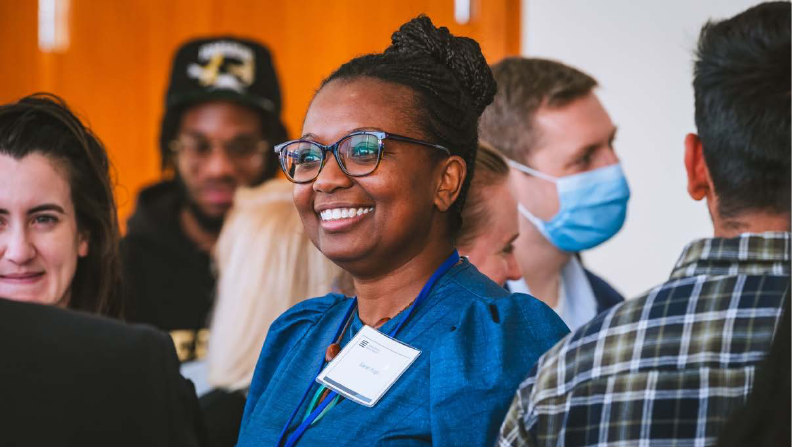
2023 Annual Report to Congress
Federal Reserve Bank of Boston | bostonfed.org | Office of Minority and Women Inclusion
11
Section III. The Bank’s Commitment to a Diverse and
Inclusive Workforce
At the Boston Fed, we remain dedicated to creating an inclusive environment and
providing employment and advancement opportunities equitably. We believe that
fostering an inclusive work environment is essential to achieving our mission, which
requires a wide range of perspectives and the very best of everyone. A diverse team
broadens perspectives and ultimately expands our capacity to serve the public. We find
that the Bank’s commitment to DEI benefits all aspects of our operations.
The Boston Fed hosts a reception for new employees to meet and network with
colleagues from across the organization, including senior leaders.
In 2023, the Bank made additional progress incorporating important and beneficial
aspects of diversity, equity, and inclusion into the organization’s policies and practices.
Examples include establishing DEI foundational learning as a part of talent management
and succession-planning processes. We also enhanced analytics, and the Office of
Diversity, Equity & Inclusion (ODEI) held engagement meetings in each department,
which resulted in a robust DEI action-planning process. For the first time, 100% of
departments completed DEI action plans.
A. Successes, Strategies, and Initiatives
1. Leadership
Bank leaders are dedicated to supporting, driving, and championing efforts to provide
equal access and opportunity to all employees and job candidates. This is reflected in
their roles in the following actions and initiatives:
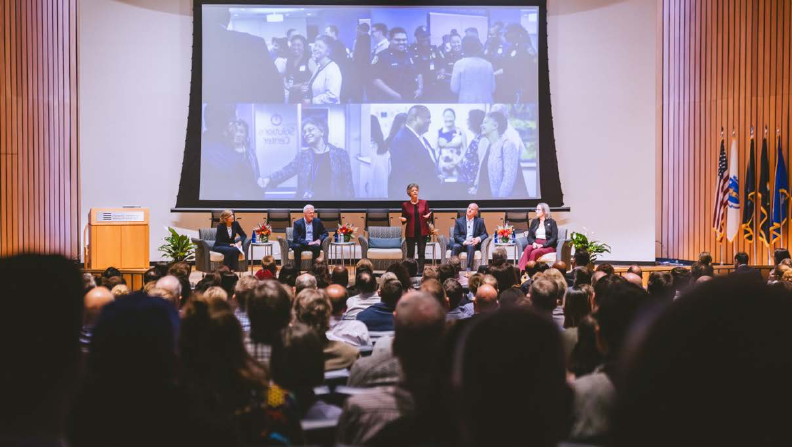
2023 Annual Report to Congress
Federal Reserve Bank of Boston | bostonfed.org | Office of Minority and Women Inclusion
12
• Diversity at the Bank’s top governing levels: As of 2023, the Board of Directors
continued to be diverse in gender and race/ethnicity when compared with the
financial industry benchmarks (Spencer Stuart 2023 Financials Sector Study).
• The Executive Committee’s support for DEI: The Executive Committee (or EC)
serves as the DEI Executive Council. In this role, the EC provides insight and
guidance on the Bank’s overall DEI strategy, helps to identify priorities, ensures
accountability, and delivers top-down support for sustainable DEI initiatives.
• Employee Resource Group (ERG) sponsors: Bank officers act as sponsors for our
ERGs. Their responsibilities include supporting ERG strategies, attending events,
and mentoring and developing ERG chairs.
2. Strengthening the Organization and Culture
Members of the Boston Fed's Executive Committee participate in an employee town hall
event to discuss the Bank's strategic plan and priorities. Leaders encouraged each
employee to see a role in helping achieve it.
• DEI metrics report, department Engagement Meetings, and action plans: The ODEI
team worked to enhance reportable metrics by aggregating data sources into
dashboards. Throughout the year, ODEI and Human Resources met with all
department leaders and their executive committee members to discuss successes
and opportunities and create customized DEI action plans for their specific areas.
These metrics are a constructive, illuminating tool that supports shared
understanding and informed action-planning.
• “Listen, Consider, and Respond” playbook: As part of a leadership development
program known as “Thrive,” several of the Bank’s emerging leaders created a playbook

2023 Annual Report to Congress
Federal Reserve Bank of Boston | bostonfed.org | Office of Minority and Women Inclusion
13
on how to respond to input called “Listen, Consider, and Respond.” The playbook also
outlines ways to support a listening culture and has been widely adopted.
• Performance Rating Calibration across the Bank: The Bank improved performance
rating calibration across the organization in 2023, to provide a clearer and more
consistent framework for evaluating employees and mitigating the potential for bias.
Calibrated performance ratings are crucial for consistency and fairness in evaluating
employees, aligning performance standards with organizational objectives, and
promoting transparency. The goal is to improve objectivity in employee performance
assessment and minimize rater-bias. Training on performance rating definitions and
calibration helped cement the Bank’s commitment to equity in the performance-rating
process. More than 650 Bank leaders and employees took part in performance
management sessions aimed at ensuring consistent performance ratings and
feedback processes and practices Bank-wide.
• Talent Engagement Conversations: This is a process encouraged across the Bank in
which managers engage in periodic conversations with team members to create a
foundation for effective collaboration. It also aligns individual goals with the Bank’s
objectives, builds trust, and ensures that employees feel supported and empowered.
These structured dialogues help managers demonstrate that employees are valued
and heard.
3. Expanded Employee Resource Networks for Greater
Inclusion and Engagement
Boston Fed President & CEO Susan Collins is joined by leaders of the Bank's employee
resource and affinity groups.
The Boston Fed has a strong history of employee resource group programs and
membership. In 2023, the Bank had eight employee resource groups (or ERGs) and
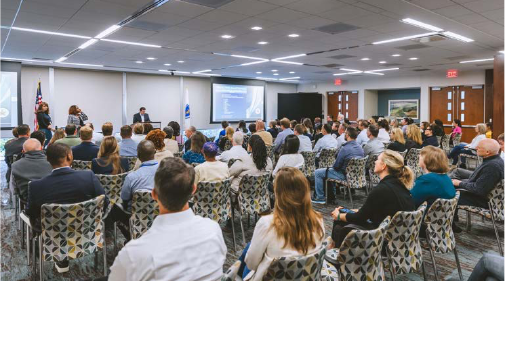
2023 Annual Report to Congress
Federal Reserve Bank of Boston | bostonfed.org | Office of Minority and Women Inclusion
14
three affinity groups (or AGs). The members of AGs share a professional focus or
common interest, fostering inclusivity and cultivating meaningful connections among
employees. The ERNs and the ODEI co-hosted a variety of learning and cultural events
throughout the year.
Additionally, an inaugural ERG/AG
DIWG (Diversity and Inclusion Working
Group) leadership awards ceremony
was held in January 2023 to increase
employee interest in and commitment
to ERG, AG, and DIWG goals. An ERG
Leaders Training Summit was also
held in June.
An Employee Resource Network
membership subscription tool was
created to assess Bank membership in
the groups. The data it collected
indicated 20% of the Bank population
had joined an ERG or AG as of the end of 2023. These metrics will help measure
progress in ERN employee engagement.
In 2023, three new groups were added to the Bank’s ERG/AG lineup:
• Building Tomorrow: An environmentally focused employee engagement AG created
to empower building occupants to collectively act on sustainability initiatives.
• Ability Beyond the Label (ABLE): An ERG in which employees can share and learn
about the experiences of those with disabilities, as well as discuss accessibility needs
and innovations.
• First District Parents Group: An ERG that recognizes the unique challenges of being
a working parent and offers a supportive environment and opportunities to exchange
helpful tactics.
Furthermore, the Bank seeks to instill a strong sense of community engagement by
encouraging employees to participate in volunteer initiatives. This aligns with the Bank’s
values and cultivates a collaborative and socially responsible environment. Staff
members collectively reported 479 hours in volunteer work in 2023.
Boston Fed staffers attend the ERG/AG/DIWG
leadership awards ceremony.
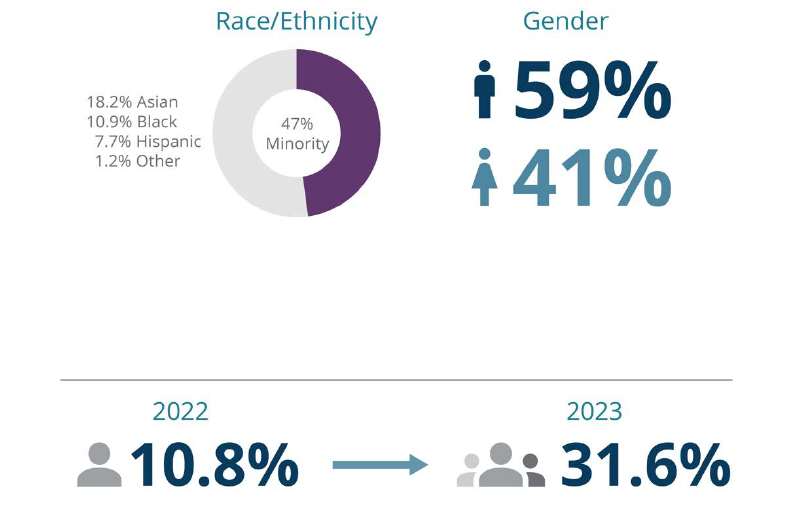
2023 Annual Report to Congress
Federal Reserve Bank of Boston | bostonfed.org | Office of Minority and Women Inclusion
15
4. Recruited a Diverse Workforce
In 2023, the Bank recruited 137 new employees. Among the new hires, 41% were
women and 47% were minorities. This achievement reflects a purposeful commitment to
expanding awareness of openings. The Bank was strategically focused on recruiting new
talent with diverse perspectives and varied experiences. The Boston Fed has hired
candidates from a wide range of industries, including financial services, biotech/pharma,
information technology, and consulting.
Additionally, the Bank recruited 38 college and graduate school interns and saw a
substantial increase in minority, especially Black, representation in 2023.
Black Intern Demographics
Outreach to candidates primarily involved job boards, employment branding sites,
diversity networks, university postings, social media networks, and expanded solicitation
of employee referrals. Successful candidates came most frequently from the Federal
Reserve System internal career site (21%), employee referrals (20%), and the Federal
Reserve Bank of Boston website (19%).
Many of the outreach, selection, and engagement strategies concentrate on expanding
the applicant pool, in part through increased awareness of openings generated by a
variety of outreach and engagement initiatives. They also focus on increasing awareness
of the Boston Fed with local higher education institutions and external organizations
through job fairs and in employment advertising. This included sharing articles, regular
job postings, inviting partners to the Bank, advertising, and social media posts.
Prospective employees were also reached through state and local employment networks,
minority job-placement organizations, and local colleges.

2023 Annual Report to Congress
Federal Reserve Bank of Boston | bostonfed.org | Office of Minority and Women Inclusion
16
The Bank also partnered with organizations dedicated to providing information about
employment opportunities in a range of communities. These organizations include the following:
• MassHire, a statewide employment network, which was utilized specifically to recruit
for Cash Services operations.
• Pipeline with Purpose, which reaches into local community colleges and high schools.
• The United Negro College Fund’s Lighted Pathways program, which places students
from historically Black colleges and universities in internships with employers in the
Boston area.
• iRelaunch STEM Workforce Council. This affiliation resulted in two hires.
• Massachusetts Chamber of Commerce LGBTQ+, El Mundo Boston, and the Urban
League of Eastern Massachusetts
• Recruit Military, which allows the Bank to post vacancies on its job board.
• Curry College, Bentley University, Westfield State University, Massachusetts
Maritime Academy, and UMass Boston
• The Diverse Talent Connections networking event, during which the Bank welcomed
professionals and students from the Greater Boston area to learn about its key
functions, culture, and employment opportunities.
5. Utilized College and Graduate School Internships
The Bank is committed to investing in entry-level talent. This allows the organization to
guide and develop future leaders from within, which fosters engagement and commitment.
The Bank supports college and graduate students by offering internship opportunities.
The interns receive essential job experience, and they, in turn, provide the Bank with a
known pool of potential candidates for full-time positions. Of the Bank’s 38 paid interns,
47% were female, compared to 42% in 2022. Minorities represented 74% of interns in
2023, compared to 43% in 2022. It is especially notable that the percentage of Black
interns substantially increased, from 11% to 32%. Between 2021 and 2023, the Bank’s
total intern population was 99 students. During this period, six former interns returned to
the Bank as full-time employees.
Intern Demographics
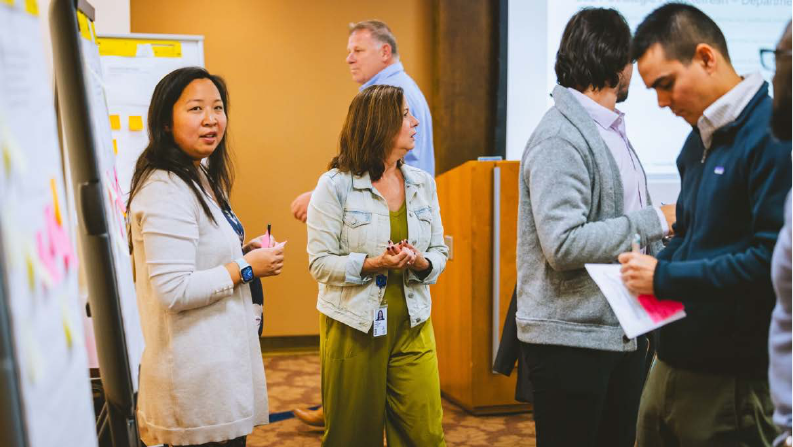
2023 Annual Report to Congress
Federal Reserve Bank of Boston | bostonfed.org | Office of Minority and Women Inclusion
17
For additional details, see the table on intern demographics in the section below.
6. Focused on Development, Learning, and Retention,
With Opportunities for All
The Boston Fed recognizes the critical importance of nurturing talent, promoting growth,
and ensuring equal opportunities for employees. Development and retention efforts play
a pivotal role in achieving an inclusive environment. And we work to ensure equal access
to development opportunities that support career progression for all employees. Tactics
include mentorship, leadership development, and establishing pathways that facilitate
career advancement.
At the Bank, we continue to work to ensure opportunities for personal and professional
development are open to all. This has led to a welcome increase in minority
representation in our learning and development programs, which supports our goal to
build a diverse pipeline across our workforce and our leadership levels. In 2023, the Bank
offered numerous learning and development programs. These programs helped
employees accelerate growth through the development of skills, knowledge, and
leadership insights. Female and minority participation was 61% and 44%, respectively. In
total, 145 Bank employees participated in these programs. Minority representation has
increased significantly in recent years, rising from 19% in 2018 to 42% in 2023.
Audit staffers participate in engaging group training exercises.
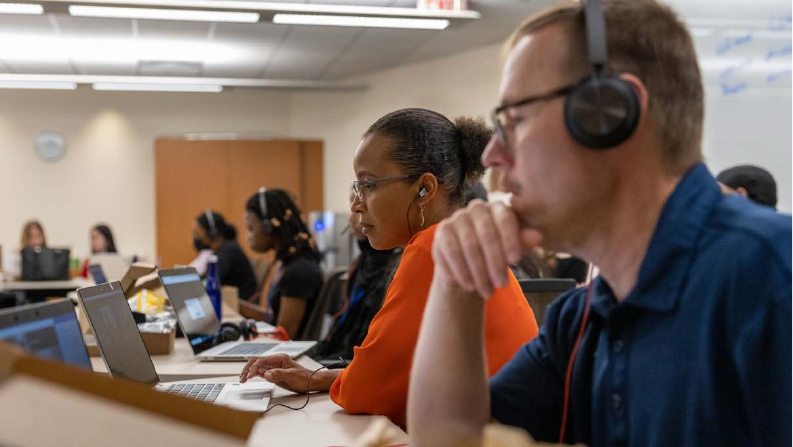
2023 Annual Report to Congress
Federal Reserve Bank of Boston | bostonfed.org | Office of Minority and Women Inclusion
18
Examples of these programs follow:
Bank and Federal Reserve System programs
• Mentoring Circles Program: This program is an important driver of inclusion and career
development at the Bank. It is continually enhanced based on participant feedback and
the Bank’s desire to provide an ever more inclusive experience, while meeting the
career development needs of mentees. The mentoring program has proven an
effective springboard to other career development opportunities, including the Bank’s
leadership programs. Out of 50 participants, 62% were females and 42% minority.
• Essential Skills for Supervisors/Managers: The program provides participants with
the knowledge and tools to help develop their teams, maximize employee
performance, and foster a positive work environment. Out of the 33 participants, 36%
were female and 48% minority.
Boston Fed employees participate in a training session.
• Thrive: The program is designed to develop leadership capabilities and expose
participants to the challenges and realities of leading in the Federal Reserve System.
Out of the 11 participants, 82% were female and 36% minority.
• Executive Presence Coaching: This program enables participants to lead teams and
organizations effectively by enhancing their presence, communication skills, and
overall leadership perception, which improves their ability to influence and lead. Out
of the nine participants, 56% were female and 33% minority.
• Trailblazers: The program, offered to officer-level staff, is designed to develop the
leadership skills Bank officers need to lead within their function. Out of the five
participants, 80% were female and 0% minority.
2023 Annual Report to Congress
Federal Reserve Bank of Boston | bostonfed.org | Office of Minority and Women Inclusion
19
• Reach Program: The program emphasizes solving business problems and exploring
new career possibilities. It encourages innovative approaches, and it increases
collaboration by requiring participants to reach outside their comfort zones and use
their talents to develop professional capabilities. Out of the two participants, 50%
were female and 50% minority.
External Programs that Bank staff attended
• Babson Women’s Leadership Program: The program is designed to empower women
to become more impactful and effective leaders. It prepares participants to
understand and use culture, structure, and processes to enhance their leadership
journey. Out of the 13 female participants, 54% were minority.
• Bentley University Mini MBA: The program is designed to provide a strong foundation
in key business disciplines, effective leadership styles, organizational behavior,
business ethics, and financial fundamentals. Out of the seven participants, 43% were
female and 57% minority.
• Greater Boston Chamber of Commerce Women’s Leadership Program: This program
focuses on networking, skills building, negotiation, and personal leadership
development. Out of the five female participants, 40% were minorities.
• The Partnership (three programs): The Partnership offers three leadership
development programs for professionals of color: Associates, Fellowships, and Next
Generation Executives. They are designed to help participants build the skills and
knowledge needed to excel and advance to the next level. Out of five participants,
20% were female and 80% minority.
• UMass Boston Emerging Leaders Program: This program aims to provide a
transformational leadership development experience built on teamwork, trust, and
respect for diversity of thought. Out of two participants, 100% were female and 50%
minority.
• Greater Boston Chamber Future Leaders: The program provides emerging leaders
with the tools to become civically engaged, and it offers the opportunity to apply the
knowledge gained to experiential assignments. Of the two participants, one was
female, and none were minority.
• Conexiòn programs: These programs are for Hispanic-Latinae professionals in the
early or mid-stages of their careers. The curriculum builds competence in three key
leadership areas: self-leadership, relationship skills, and organizational skills. One
Hispanic female participated in the program.
DEI Training and Other Programs
• Diversity Equity and Inclusion Ted Talk Pilot: ODEI offered access to 20 TEDx talks
on a wide variety of diversity, equity, and inclusion topics. People leaders can use the
talks during trainings and department meetings.
2023 Annual Report to Congress
Federal Reserve Bank of Boston | bostonfed.org | Office of Minority and Women Inclusion
20
• Mitigating Bias in the Hiring Process: This program uses LinkedIn Learning modules
on best practices on recruiting, interviewing, and hiring processes. The training was
developed for individuals involved in hiring practices. It raises awareness on potential
biases that may arise during the hiring process.
• Learning to Go Hybrid: This Bank-wide series was completed to support employees
working a hybrid schedule. The series covered the many dimensions and norms of
the hybrid work culture. It consisted of four sessions and reached more than 600
employees, about half of the Bank’s employee population.
B. Ongoing Challenges and Next Steps
• The Bank continues to hire strong, capable talent, and we work to build diverse
candidate pools. However, attracting female candidates continued to be a challenge
in the Bank’s employee recruitment efforts in 2023. The Bank continued efforts to
identify female candidates, particularly in technical roles, by taking advantage of the
relationships we have with universities, agencies, and the organizations we recruit
from when sourcing many of our diversity candidates.
• The Bank’s ERNs are growing and membership is increasing. There is a need for
additional guidance and connectivity to leadership, including chairs and executive
sponsors. Since ERNs serve as places of employee development, we continue to
need to create space for employee participation.
• A number of impactful programs have been implemented by the ODEI. Further
incorporation of these programs into the Bank’s culture will be beneficial.
• The Bank will continue to engage partners that focus on ways to draw female job
seekers, including job boards, minority development organizations, and professional
associations.
• The organization will also improve the focus on entry-level hiring by increasing
dialogue with new sources of entry-level candidates, including higher education
institutions and skill-based development programs throughout the First District.
• Integration of DEI Experiential Learning: ODEI will continue to work closely with
Human Resources to implement trainings that highlight and address biases and their
impact on the decision-making process in hiring, performance evaluation, and
identifying high-potential job candidates.
• Recruiting ERG/AG sponsors and chairs: ERGs and AGs require significant time and
energy from volunteers, and it can be difficult to find new sponsors and chairs or
create strong leadership pipelines for each group. It will be important to redouble
recruiting efforts.
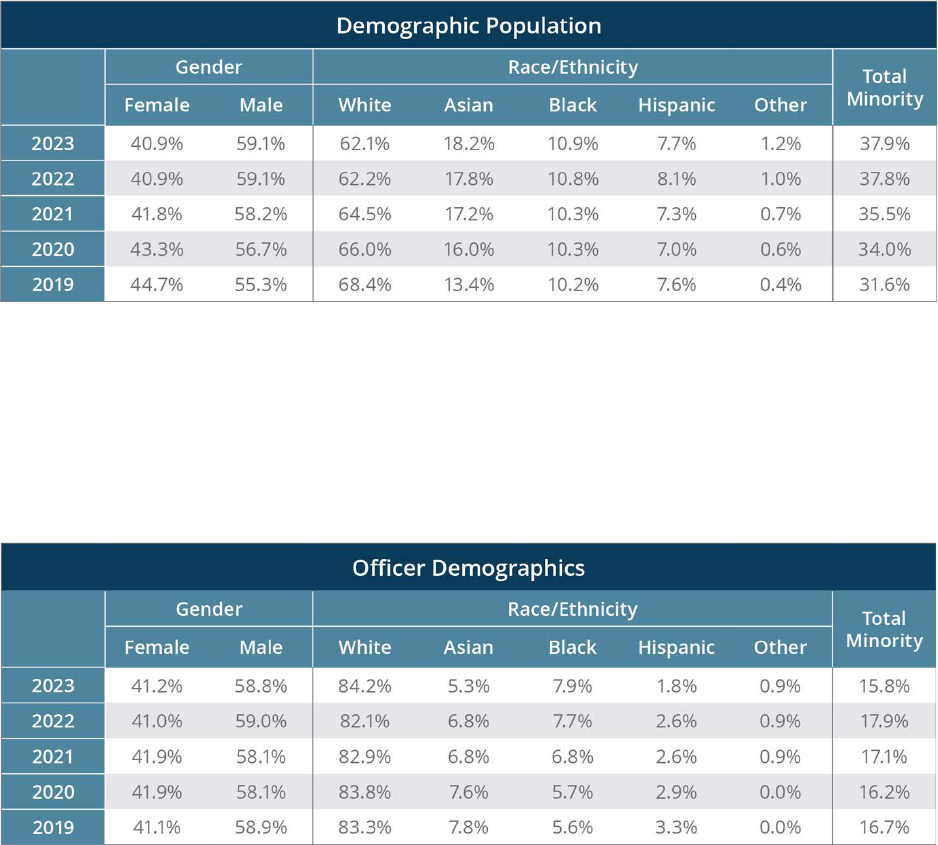
2023 Annual Report to Congress
Federal Reserve Bank of Boston | bostonfed.org | Office of Minority and Women Inclusion
21
C. Workforce: Demographic Composition Results
The tables below provide additional detail on the Bank’s workforce composition, as
required in Equal Employment Opportunity reports.
1. All Employees
The Bank’s workforce increased by 1%, from 1,263 in 2022 to 1,280 in 2023. Female and
minority representation has remained consistent, with female representation at 41% and
minority representation at 38% both years.
The Other category includes two or more races, Native Americans or Alaska Native, or Hawaiian
Native or Other Pacific Islanders.
2. Leadership
Officer positions decreased from 117 in 2022 to 114 in 2023. Female officer
representation remained unchanged at 41%. Minority officer representation slightly
decreased, from 18% in 2022 to 16% in 2023.
Officers include assistant vice president, vice president, senior vice president, executive vice
president, first vice president and chief operating officer, and president and chief executive officer.
The Other category includes two or more races, Native Americans or Alaska Native, or Hawaiian
Native or Other Pacific Islanders.
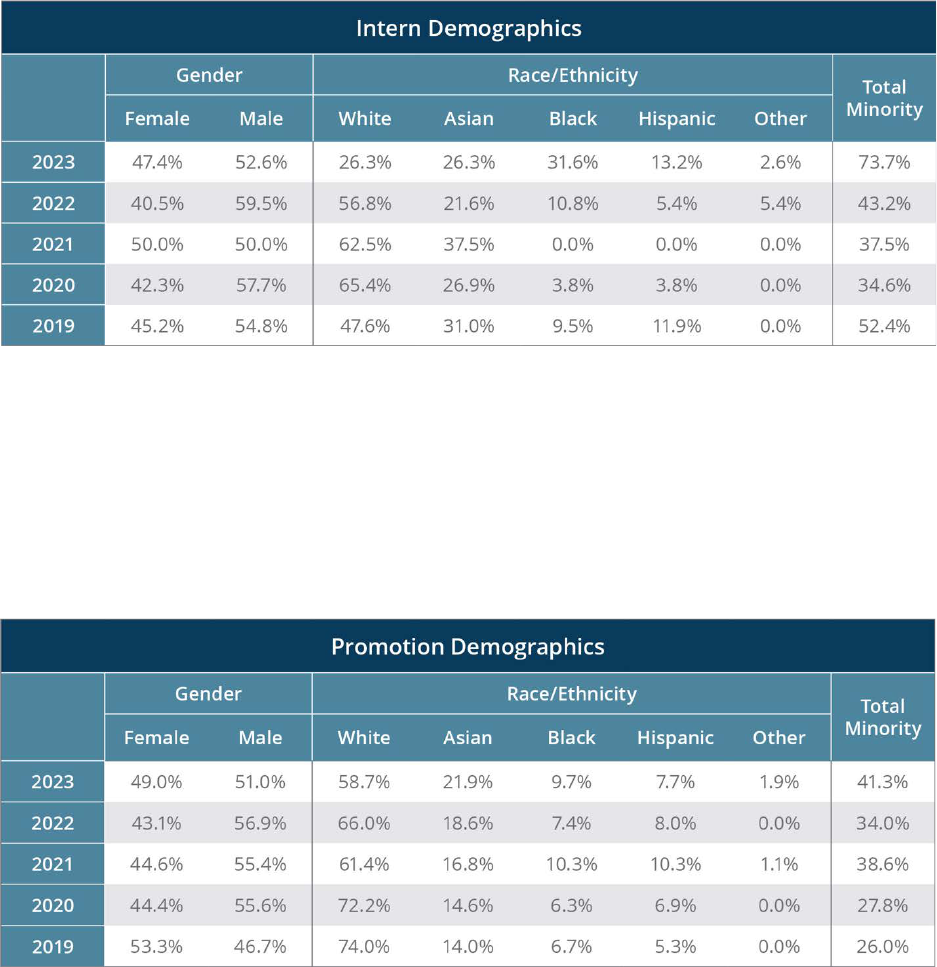
2023 Annual Report to Congress
Federal Reserve Bank of Boston | bostonfed.org | Office of Minority and Women Inclusion
22
3. Interns
The Bank is committed to investing in entry-level talent. This allows the organization to
guide and develop future leaders from within, which fosters engagement and commitment.
The Other category includes two or more races, Native Americans or Alaska Native, or Hawaiian
Native or Other Pacific Islanders.
4. Promotion Results
The Bank promoted 155 employees in 2023. Females made up 49% of those promoted,
up from 43% in 2022 and above their overall representation in the Bank population
(40%). Minorities represented 41% of those promoted, up from 34% in 2022 and above
their overall representation in the Bank population (38%).
The Other category includes two or more races, Native Americans or Alaska Native, or Hawaiian
Native or Other Pacific Islanders.
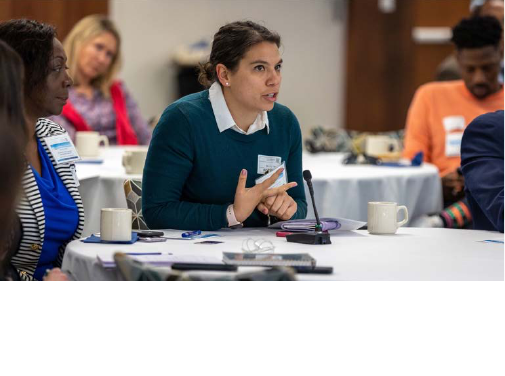
2023 Annual Report to Congress
Federal Reserve Bank of Boston | bostonfed.org | Office of Minority and Women Inclusion
23
Section IV. The Bank’s Inclusion of Minority-
and Women-Owned Vendor Businesses:
Supplier Diversity Program
The supplier diversity program at the Bank, led by ODEI, is part of a business strategy
that aims to provide suppliers from a wide range of backgrounds equal access to the
Bank’s sourcing and purchasing
opportunities. Suppliers include
minority- and women-owned
businesses.
Reportable diverse spend was $10.1
million in 2023, or 12% of overall
spend. This was a decrease of $2.8
million, or 2% from the prior year, as
the Bank’s overall spend declined by
10%, to $82.0 million in 2023 from
$90.9 million in 2022. Despite the
decline in diverse spend, partnerships
between ODEI and various Bank
departments have resulted in several
successes. Collaboration with the Real Estate Services Group (or RESG), which focuses
mainly on large building contracts, significantly contributed to diversity spend. The
following steps have been taken to advance supplier diversity.
A. Successes
• Partnerships with departments: The supplier diversity program has developed close
partnerships with key departments, including RESG, to focus on bidding for large
building contracts. While minority- and women-owned businesses have not won the
larger contracts, they have been given increased opportunities to participate. In a few
cases, such businesses represented one of two finalists considered.
• Contract review and segmentation to create more opportunities: ODEI worked closely
with RESG to break down a large cleaning contract into multiple smaller contracts that
provided more opportunities for minority- and women-owned businesses. To date,
ODEI has provided RESG with 11 diverse suppliers to consider over seven contracts.
Of the five that have been awarded, one went to a women-owned business.
• Increased networking with new suppliers: The supplier diversity manager continues
to build a comprehensive list of vetted diverse suppliers that departments can consult
when they have procurement needs. In 2023, the supplier diversity manager
engaged 91 diverse suppliers via direct outreach.
An audience member asks a question during the
“Opportunities and Barriers in Procurement” session of
the Boston Fed’s first annual Financial Summit.
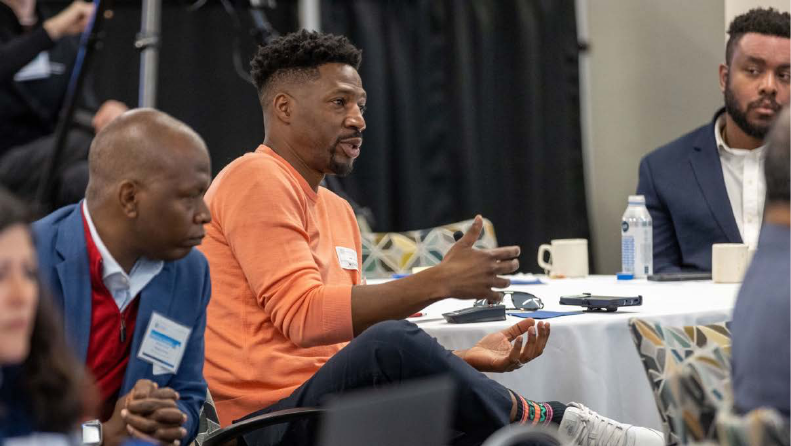
2023 Annual Report to Congress
Federal Reserve Bank of Boston | bostonfed.org | Office of Minority and Women Inclusion
24
An audience member asks a question during the "Economic Outlook" session of the
Boston Fed's first annual Financial Summit. May 18, 2023.
• Hosted the Bank’s first financial summit: The Bank partnered with the Greater New
England Minority Supplier Diversity Council to host a 2023 financial summit that
provided essential economic and financial information to diverse businesses. The
topics included the current and future state of the economy, debt acquisition,
establishing businesses, and the wealth gap.
• Increased partnership with Procurement: ODEI and Procurement continue to
collaborate and review the Bank’s procurement process from a DEI standpoint.
B. Challenges and Next Steps
The following issues are challenges ODEI faces as it continues to focus on increasing
involvement with diverse suppliers:
• Identifying diverse suppliers to participate in and be selected for competitive bids: A
diverse supplier’s “capacity” often does not speak to the quality of the work/goods
provided. The supplier diversity manager aims to provide individual departments with
diverse suppliers who have strong reputations and can satisfy their request for
proposal/request for quote (RFP/RFQ) specifications. However, the Bank has some
needs for which a diverse supplier cannot be sourced.
• Maintaining a current list of diverse suppliers who are either already certified or in the
final stages of obtaining certification: An initial listing of suppliers has been
established, but the goal is to make it a living document with suppliers who have
been vetted and can be included in future RFQs.
• Exploring why diverse suppliers do not respond to request for proposal invitations,
determining if barriers exist, and working to mitigate those barriers.

2023 Annual Report to Congress
Federal Reserve Bank of Boston | bostonfed.org | Office of Minority and Women Inclusion
25
• Ensuring timely discussions between the supplier diversity manager and departments,
to make it easier to research and acquire new vendors when they are needed.
Section V. Concluding Observations
This report has detailed the many ways that the Federal Reserve Bank of Boston sees
diversity, equity, and inclusion as essential to our mandate and mission to serve the
public by promoting a vibrant economy. We look forward to continuing to serve all
members of the public.
The Federal Reserve Bank of Boston, located in the heart of downtown Boston.
The
Boston Fed serves the New England region - Connecticut (except Fairfield County),
Maine, Massachusetts, New Hampshire, Rhode Island, and Vermont.

Appendix
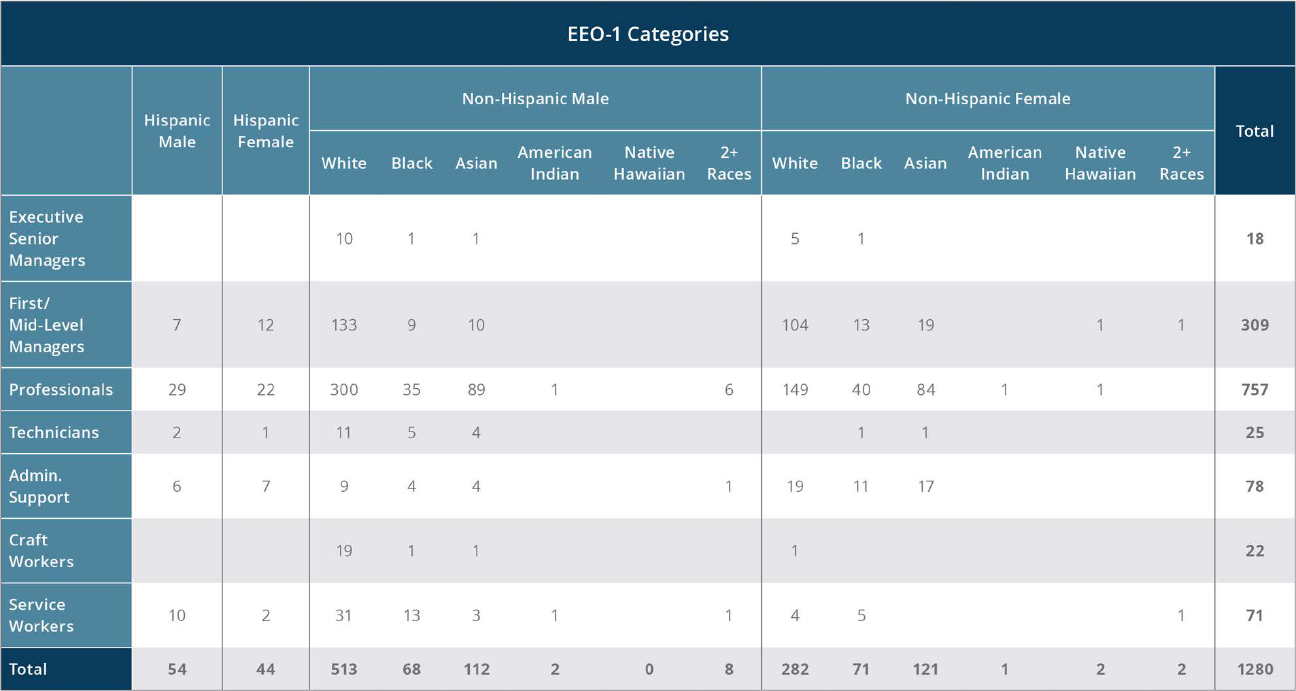
2023 Annual Report to Congress
Federal Reserve Bank of Boston | bostonfed.org | Office of Minority and Women Inclusion
27
Appendix A: EEO1 Report
The information in these tables reflects the 1st District's staff representation by EEO-1 job category.
The vertical “Total” column represents total staff for the job category across all races and gender, the horizontal “Total” row represents total staff
for the race-gender combination across all categories.

2023 Annual Report to Congress
Federal Reserve Bank of Boston | bostonfed.org | Office of Minority and Women Inclusion
28
Each cell represents the race-gender’s share of the relevant job category (row). The vertical “total” column must always equal 100%. The
horizontal “Total” need not equal 100% because it represents the race-gender’s share of the entire bank across all job categories.

2023 Annual Report to Congress
Federal Reserve Bank of Boston | bostonfed.org | Office of Minority and Women Inclusion
29
Appendix B: OMWI Standard Metrics Report
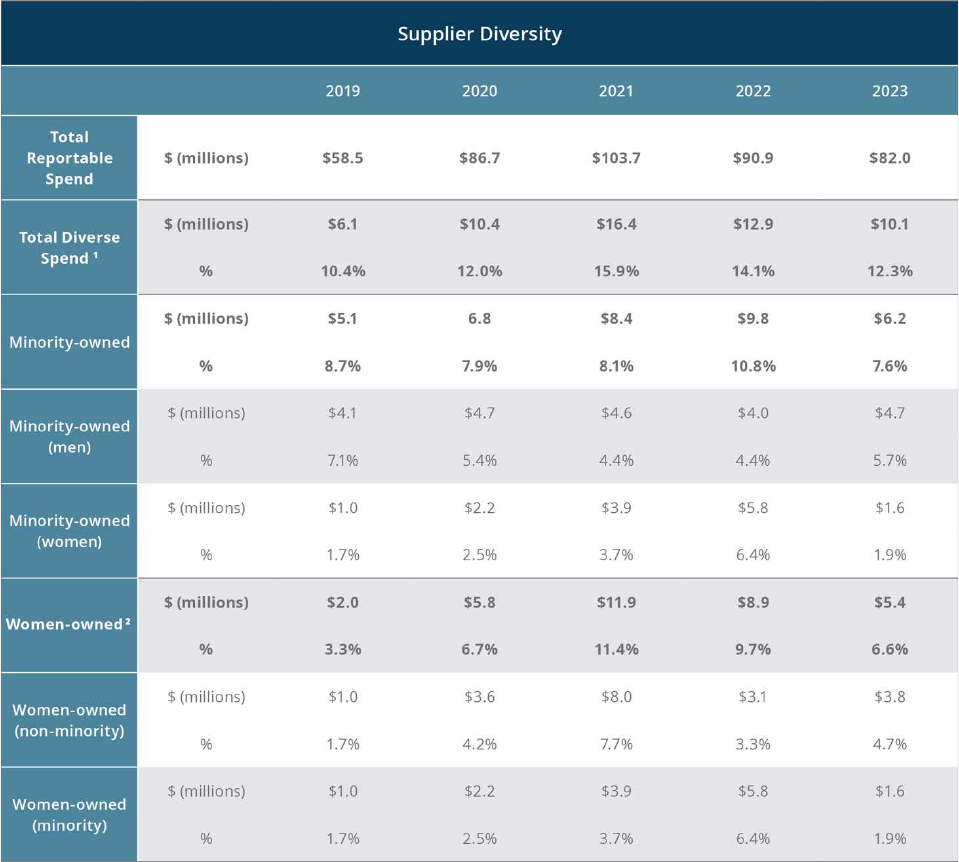
2023 Annual Report to Congress
Federal Reserve Bank of Boston | bostonfed.org | Office of Minority and Women Inclusion
30
30
1
Total Diverse Spend = Minority-owned (men) + Minority-owned (women) + Women-owned
(non-minority).
2
Women-minority numbers are included in both Minority-owned and Women-owned Totals.

2023 Annual Report to Congress
Federal Reserve Bank of Boston | bostonfed.org | Office of Minority and Women Inclusion
31
31
1
Measures report only those OMWI students and teachers who participate in or are reached
through programs that have a financial literacy focus.
2
Students who attended in-person programs and enrolled in online programs.
3
Educators who attended in-person programs and enrolled in online professional
development programs.
4
Students reached through educators using a common multiplier of 75.
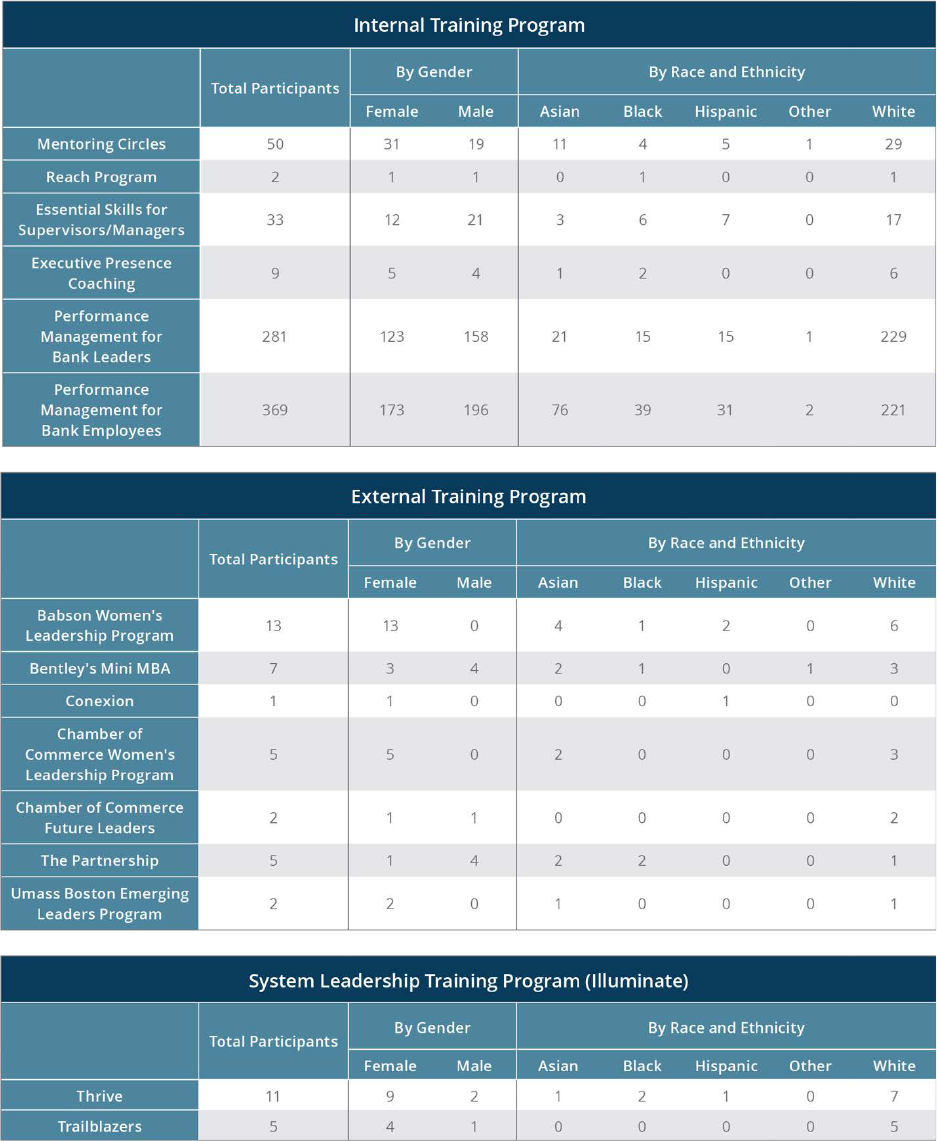
2023 Annual Report to Congress
Federal Reserve Bank of Boston | bostonfed.org | Office of Minority and Women Inclusion
32
32
Appendix C: 2023 Learning and
Development Training Programs
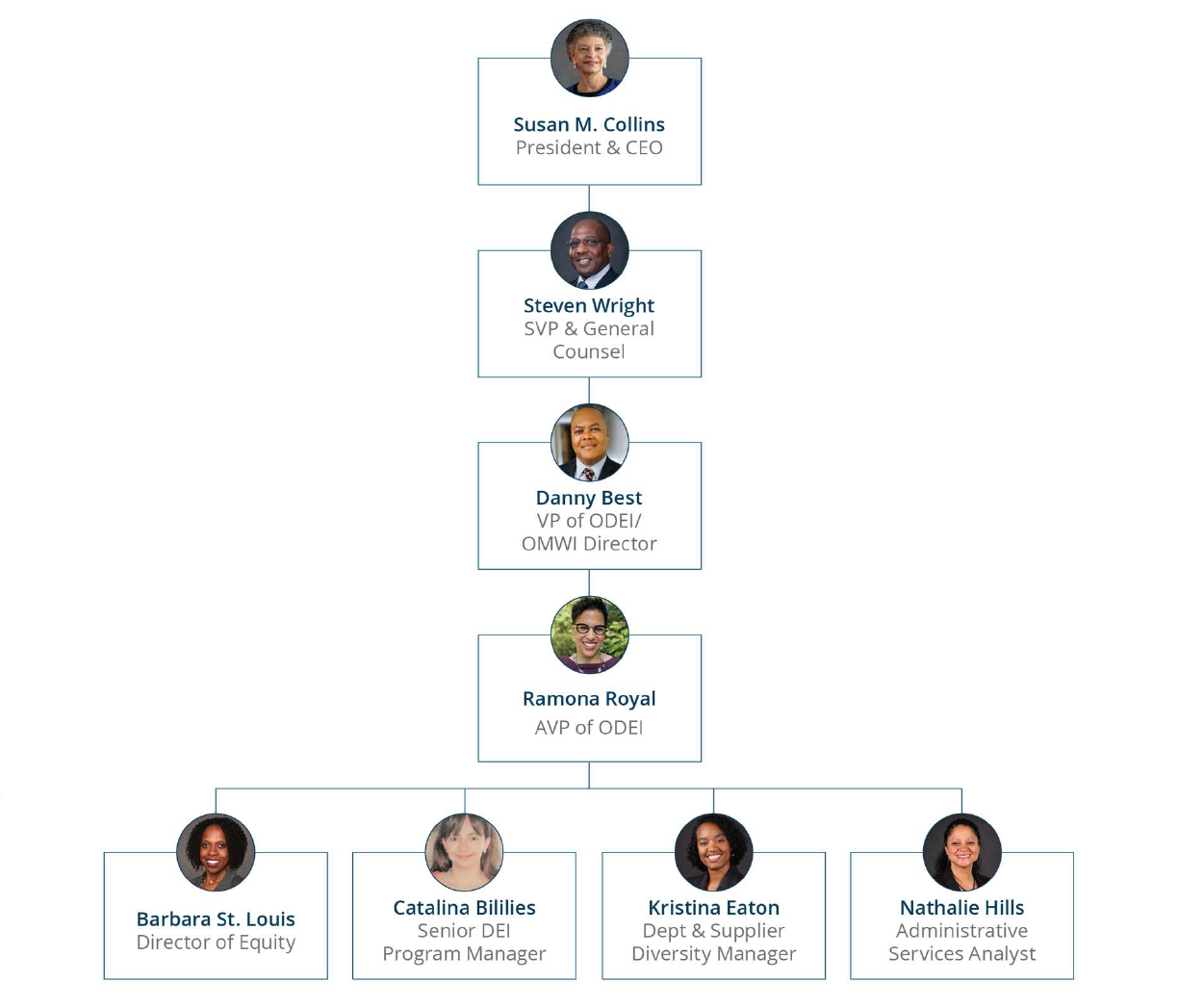
2023 Annual Report to Congress
Federal Reserve Bank of Boston | bostonfed.org | Office of Minority and Women Inclusion
33
33
Appendix D: Organization Chart

2023 Annual Report to Congress
Federal Reserve Bank of Boston | bostonfed.org | Office of Minority and Women Inclusion
34
34
